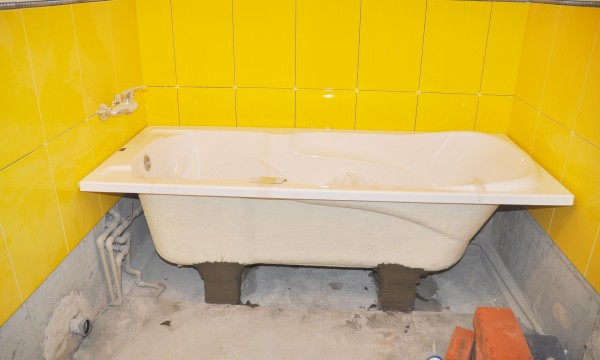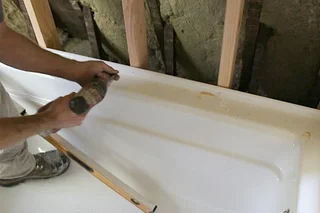Can I Set Up A Tub Myself?
Can I Set Up A Tub Myself?
Blog Article
What're your opinions with regards to How to Install a Bathtub?

Installing a bathtub isn't precisely brain surgery, yet it does call for strong plumbing, woodworking, and also occasionally, tiling abilities. Changing an old bath tub with a brand-new one is likewise a reasonably tough job. If the old bathtub is conveniently obtainable, the job can move rapidly; if you need to open a wall to remove the old tub and also place the brand-new bath tub, the job is much harder. In either situation, the project is within a home handyman's abilities, although you will certainly need a helper to vacate the old bathtub and set in the brand-new one. Make certain you have qualified on your own for the task as well as fit attempting it. Rather than working with a specialist to take over a halfway-completed project, it is far better to think about employing one prior to you begin. Chances are you might need a professional plumber to make tube connections.
This write-up will aid you install a brand-new tub in your bathroom if you have currently bought a brand-new bathtub and do not require to change the plan of your previous water system pipelines.
Your tools and material list need to comprise the following:
Removing Old Touches
If you need to replace old taps with brand-new ones as a part of your installment, after that the first thing you should do is disconnect the supply of water. After doing so, switch on the faucets to drain pipes any kind of water staying in the system. The process of eliminating the existing faucets can be quite troublesome as a result of the restricted gain access to that is usually the case.
Utilize a container wrench (crowsfoot spanner) or a tap tool to reverse the nut that attaches the supply pipes to the taps. Have a towel ready for the staying water that will certainly originate from the pipes. When the supply pipelines have actually been removed, utilize the exact same device to loosen up the nut that holds the faucets onto the bath/basin. You will need to quit the single taps from transforming throughout this process. When the faucets have been eliminated, the holes in the bath/basin will certainly need to be cleaned of any type of old securing compound.
Before carrying on to fit the brand-new taps, compare the pipeline links on the old taps to the brand-new faucets. If the old faucets are longer than the new taps, after that a shank adapter is needed for the brand-new faucets to fit.
Suitable New Taps
If the tails of the new taps are plastic, then you will require a plastic adapter to avoid damages to the string. One end of the adapter fits on the plastic tail of the faucet and the other end offers a connection to the existing supply pipelines.
If you require to fit a monobloc, after that you will certainly call for lowering couplers, which attaches the 10mm pipeline of the monobloc to the standard 15mm supply pipe.
Next, position the tap in the installing hole in the bath/basin guaranteeing that the washers are in location between the tap as well as the sink. Protect the tap in place with the producer provided backnut. Once the tap is firmly in position, the supply pipelines can be attached to the tails of the faucets. The faucets can either be attached by utilizing corrugated copper piping or with typical faucet ports. The former type ought to be attached to the faucet finishes first, tightening only by hand. The supply pipes can later be attached to the various other end. Tighten up both ends with a spanner after both ends have actually been linked.
Setting up the Bathtub
Using both wooden boards under its feet, put the bathtub in the required placement. The wood boards are practical in uniformly spreading the weight of the bathtub over the location of the boards as opposed to concentrating all the weight onto four small points.
The following objective is to make sure that the tub is leveled all round. This can be achieved by examining the level as well as changing the feet on the bathtub till the level checks out level.
To mount faucets, fit the bottom of the furthest adaptable faucet port to the appropriate supply pipeline by making a compression sign up with; then do the same for the various other faucet.
Switch on the water supply and also inspect all joints and brand-new pipework for leaks and also tighten them if needed. Fill up the bathtub and additionally examine the overflow outlet and the normal electrical outlet for leakages.
Finally, fix the bathroom paneling as explained in the producer's instruction manual. Tiling and also securing around the tub should wait up until the bathtub has actually been utilized at least when as this will certainly settle it right into its last position.
Preparing for the Installment
First of all, the supporting structure supplied with the bath needs to be fitted (if needed) according to the manufacturer's guidelines. Next, fit the faucets or mixer to the tub. When fitting the faucet block, it is important to see to it that if the tap comes with a plastic washing machine, it is fitted between the bathroom as well as the faucets. On a plastic bathroom, it is also reasonable to fit a supporting plate under the faucets system to stop stress on the bathtub.
Fit the versatile tap adapters to the bottom of the two faucets using 2 nuts and also olives (in some cases provided with the tub). Fit the plug-hole electrical outlet by smearing mastic filler round the sink outlet opening, and after that pass the electrical outlet with the hole in the bathroom. Use the nut provided by the producer to fit the plug-hole. Check out the plug-hole outlet for an inlet on the side for the overflow pipeline.
Next, fit completion of the flexible overflow pipe to the overflow electrical outlet. After that, screw the pipeline to the overflow face which should be fitted inside the bathroom. Make sure you utilize every one of the supplied washing machines.
Connect the catch to the bottom of the waste electrical outlet on the tub by winding the string of the waste outlet with silicone mastic or PTFE tape, as well as screw on the catch to the outlet. Link all-time low of the overflow tube in a similar manner.The bathroom should now prepare to be fitted in its final placement.
Tiling Around the Bathtub
In the area where the bathroom meets the ceramic tile, it is essential to seal the joins with a silicone rubber caulking. This is necessary as the fitting can move sufficient to fracture a stiff seal, creating the water to penetrate the wall surface in between the bath and the tiling, causing difficulties with dampness as well as feasible leakages to the ceiling listed below.
You can choose from a variety of coloured sealants to blend in your fixtures as well as installations. They are marketed in tubes and also cartridges, and also are capable of sealing gaps up to a width of 3mm (1/8 inch). If you have a larger space to load, you can fill it with twists of soaked newspaper or soft rope. Keep in mind to always fill up the tub with water prior to securing, to enable the activity experienced when the bathtub remains in usage. The sealer can split rather very early if you do not think about this activity prior to securing.
Additionally, ceramic coving or quadrant ceramic tiles can be utilized to border the bath or shower tray. Plastic strips of coving, which are easy to use as well as cut to size, are also easily available on the market. It is advisable to fit the tiles using waterproof or water-proof glue and also cement.
Bathtub Installation
How Important Is A Bathtub To Your Home?
High-quality baths, showers, and other bathroom updates are necessary when considering a smart investment in your home. It’s a room that you go to every day and one that is constantly being used by guests.The bathroom is one of the top trafficked rooms in a home and also one of the most valuable in terms of home resale.
Install Piping Before Tub
You will be using your existing drain and waste vent system, but pipes required include the hot and cold water supply lines and a pipe leading to a shower head. A mixing valve and shower head are also needed. Air chambers may be required.
Position the Tub
Lower the tub into place so that the continuous flange fits against the wall studs and rests on 1’x4' or 2’x4' supports. Anchor the tub to the enclosure with nails or screws inserted through the flanges into the studs.
NOTE: Remember, bathtubs and shower stalls may require support framing. A bathtub filled with water is extremely heavy, so check building codes and framing support before installing the tub.
Assemble Drain Connections
Assemble the bathtub drain connections by connecting the tub overflow with the tub drain above the trap, not beyond it. The trap will have a compression fitting that screws over the arm of the overflow assembly.
Place a Pipe For the Shower Head
First, locate a brass female threaded winged fitting and attach it to a framing support via a screw or a nail. Then run a pipe up the wall for the shower head. Sweat or solder the other side of the brass fitting to the top of the pipe.
Attaching Hot and Cold Water Lines
Attach your water lines for both hot and cold by sweating these directly into the hot and cold ports of the mixing valve. The mixing valve will be how water enters the tub’s system, not by the pipes themselves.
Install the Spout
Extend a piece of 1/2 inch pipe, or whichever length is specified in the manufacturer’s instructions, for the tub spout. Sweat on a male threaded fitting at the end of the pipe or use a brass nipple of the proper length and a 1/2 inch cap.
NOTE: At this point you should have your rough-in plumbing work inspected before proceeding further.
Check For Leaks
Restore the water pressure and check the drain connection and the supply pipes for any sign of leaking.
estore the Bathroom Wall
Replace the wall with moisture-resistant drywall as a base for your wall covering. Seal the joints between the wall and your new tub with silicone caulk as protection against water seepage.
https://www.berkeys.com/2016/12/02/bathtub-installation-dallas/

We were made aware of that article on How to Install a Bathtub from an associate on our other domain. If you please take the time to share this post if you appreciated it. We appreciate reading our article about A Step-by-Step Guide to Installing a Bathtub.
Set Up An Appointment
Report this page